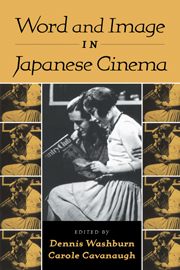Book contents
- Frontmatter
- Contents
- List of Illustrations
- Contributors
- Foreword: Outside Views of the Japanese Film
- Introduction
- PART ONE WORDING THE IMAGE/IMAGING THE WORD
- PART TWO REFLECTIONS OF IDENTITY
- PART THREE OUTSIDE THE FRAME OF CULTURE
- 12 Piss and Run: Or How Ozu Does a Number on SCAP
- 13 In the Realm of the Censors: Cultural Boundaries and the Poetics of the Forbidden
- 14 The Arrest of Time: The Mythic Transgressions of Vengeance Is Mine
- 15 The Frenzy of Metamorphosis: The Body in Japanese Pornographic Animation
- Selected Bibliography of Articles and Books in English
- Index
14 - The Arrest of Time: The Mythic Transgressions of Vengeance Is Mine
Published online by Cambridge University Press: 01 March 2010
- Frontmatter
- Contents
- List of Illustrations
- Contributors
- Foreword: Outside Views of the Japanese Film
- Introduction
- PART ONE WORDING THE IMAGE/IMAGING THE WORD
- PART TWO REFLECTIONS OF IDENTITY
- PART THREE OUTSIDE THE FRAME OF CULTURE
- 12 Piss and Run: Or How Ozu Does a Number on SCAP
- 13 In the Realm of the Censors: Cultural Boundaries and the Poetics of the Forbidden
- 14 The Arrest of Time: The Mythic Transgressions of Vengeance Is Mine
- 15 The Frenzy of Metamorphosis: The Body in Japanese Pornographic Animation
- Selected Bibliography of Articles and Books in English
- Index
Summary
Imamura Shôhei has been a sharp, sardonic critic of postwar Japanese culture, and his efforts to expose through art the effects of social inequality and political corruption display a sympathetic interest in individuals who live on the peripheries of mainstream culture. Donald Richie has noted this interest, and, citing such works as The Pornographers, observed that Imamura's films frequently celebrate “a completely amoral, vital, and overflowing rejection of Japanese collective beliefs.” Imamura's opposition to the repression of freedom and individual desire is grounded in a discontent with the ambiguities and hypocrisies of postwar culture, and this attitude of resistance has been crucial in framing his aesthetic vision. The most striking, even paradoxical, aspect of this attitude is that while it champions the individual over and against a false, degraded society, it is expressed in terms of an economy of values so absolute, so “overflowing,” that it appears mythopoeic.
My intent in noting the coexistence of the mythic impulses of Imamura's aesthetics with his individualist rejection of the coercive force of a collectivist state is to suggest that he has embraced apparently contradictory attitudes, and, thereby, to foreground a dynamic tension in his work. This tension, moreover, is bound up with his self-consciousness as an artist; that is, Imamura has consistently demonstrated an awareness of the intrusive, artificial presence of the camera an awareness that sparked his rejection of the methods of his early mentor, Ozu and an eager willingness to expose that artifice in his films.
- Type
- Chapter
- Information
- Word and Image in Japanese Cinema , pp. 318 - 341Publisher: Cambridge University PressPrint publication year: 2000



